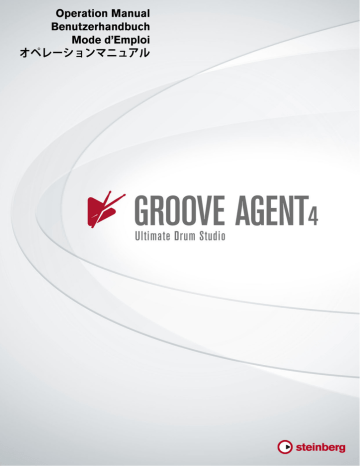

- #Groove agent 4 outputting midi generator
- #Groove agent 4 outputting midi software
- #Groove agent 4 outputting midi plus
This method lets you monitor the sound to which the volume level/effect/EQ parameters have been applied on the Cubase mixer. With the Direct Monitor off, you can monitor the sound transmitted to the computer and returned back to the instrument. With the Direct Monitor on, you can monitor the instrument sound directly from the instrument without latency. When recording to Cubase, there are two methods of monitoring: Direct Monitor "on" and "off." Direct Monitor parameter can be set on the > USB I/O display (or by selecting a Quick Setup Template) on the MOXF6/MOXF8. If you are routing the active MIDI Track's MIDI OUT to another synth engine, you will notice you will hear both synthesizers, simultaneously. If both routing paths are allowed you will hear doubling - both signals trigger the synth tone engine _ which when routed to the MOXF will sound like a very short time delay, similar to flanging or chorusing.
#Groove agent 4 outputting midi generator
In fact, in order for the MOXF keyboard to trigger the MOXF tone generator (when LOCAL is OFF) it must be routed through the active Cubase MIDI Track. If, for example, you wished to play the VSTi Yamaha YC-3B organ or Steinberg's Groove Agent, using the MOXF keyboard, by setting LOCAL CONTROL OFF, your MOXF becomes a controller _ it will not trigger itself when you press the keys or move a wheel or knob, those gestures are re-routed via the settings you make within the computer DAW.
#Groove agent 4 outputting midi software
With this type of configuration, you can understand how the MOXF keyboard and its controllers can be used to trigger any connected synthesizer or software synthesizer available to Cubase. You can see the "FROM USB" path - this is the signal coming through ("echoed back") from Cubase. If the MIDI OUT is routed to the "MOXF VST - MIDI IN" on Channel 1, for example, then the PART or PARTS assigned to MIDI Channel 1 of your MOXF will sound. The MIDI OUT setting of that Track (device + channel) will determine which tone generator will respond to the key presses of the MOXF. The "TO USB" connection travels to the computer finds its way to the currently active MIDI Track. If this connection (LOCAL CONTROL) is broken (OFF), you can see that the keyboard data will only be able to be routed out via the "TO USB" path. The KDB (keyboard) is normally connected to the MOXF TG (tone generator) direct when the Local Sw is closed (ON). Shown at left is a block diagram showing the routing of signal in the MOXF. We'll cover more about these Quick Setups below. For example, if you select QUICK SETUP = DAW REC or VST REC, Local Control will automatically be turned OFF.

The "Local Control" is one of the settings made when you select a QUICK SETUP Template. You can understand now why this is the preferred setting, because the currently selected Cubase MIDI Track OUT assignment will determine what instrument (be it the MOXF or another VSTi) you will trigger. Cubase will re-channelize the data for you. This means that the MIDI Transmit channel of your MOXF does not matter. This means you will determine which of the 16 possible PARTS will sound by setting the MIDI OUT device (MOXF) and setting the MIDI Channel number (1-16). The currently selected (highlighted) MIDI Track in Cubase will determine which Device (MIDI OUT) and which MIDI Channel, your data is Echoed Back (Thru) on.

When working with MIDI in your DAW (Cubase) Local Control should be set to OFF. You are now dependent on completing the circuit through the DAW (Cubase). With Local Control = OFF, the MOXF is disconnected from triggering itself directly - it will be looking to the USB-MIDI connection for this data. Literally, this is the Keys and Controllers of your MOXF directly addressing your MOXF Tone Generator. The normal situation is for Local Control to be set ON. Local Control is set as follows: > MIDI > SWITCH To prevent this, the Local Control parameter should be set to "off." When LOCAL CONTROL = OFF, only MIDI data coming through the computer will cause the synthesizer to produce sound.
#Groove agent 4 outputting midi plus
However, this produces an undesirable "double" sound - caused by the normal connection between the instrument's keyboard and tone generator plus the same MIDI data being returned back through the computer. MIDI data coming IN from the MOXF travel through the current Track, and is routed back to the MOXF by the Track's MIDI OUT assignment. This is commonly referred to as "Echo Back" or in Cubase as "MIDI Thru Active". When a MIDI Track is active (highlighted) Cubase will return the MIDI events that are received from the MOXF back to the instrument. MIDI "echo back" of Cubase and Local Control of the Instrument You'll discover it is not a "problem" so much as it is a choice you must make: "Dealing with Doubling" This quick guide will explain why it occurs and how you can avoid this issue. When working with a DAW software, like Cubase, a common issue is "Doubling".


 0 kommentar(er)
0 kommentar(er)
